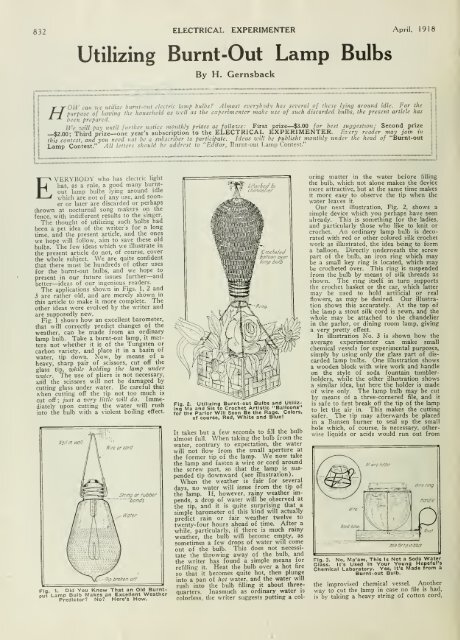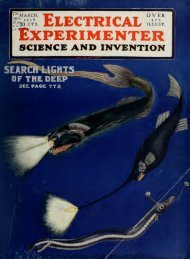The Electrical experimenter
The Electrical experimenter
The Electrical experimenter
Create successful ePaper yourself
Turn your PDF publications into a flip-book with our unique Google optimized e-Paper software.
832 ELECTRICAL EXPERIMENTER April, 1918<br />
Utilizing Burnt-Out Lamp Bulbs<br />
mil I inn ii in Mim. mi mill HI<br />
By H. Gernsback<br />
I MUNI<br />
rmrilil<br />
T TOW can we utilize burnt-out electric lamp bulbs? Almost everybody has several of these lying around idle. For the<br />
I—I purpose of having the household as well as the <strong>experimenter</strong> make use of such discarded bulbs, the present article has<br />
* been prepared.<br />
We will pay until further notice monthly prizes as follows: First prize—$3.00 for best suggestion; Second prize<br />
$2 00; Third prize one year's subscription to the ELECTRICAL EXPERIMENTER. Every reader may join vi<br />
this contest, and you need not be a subscriber to participate. Ideas will be publisht monthly under the head of "Burnt-out<br />
Lamp Contest." All letters should be addrest to "Editor, Burnt-out Lamp Contest."<br />
EVERYBODY<br />
who has electric light<br />
has, as a rule, a good many burntout<br />
lamp bulbs lying around idle<br />
which are not of any use, and sooner<br />
or later are discarded or perhaps<br />
thrown at nocturnal song makers on the<br />
fence, with indifferent results to the singer.<br />
<strong>The</strong> thought of utilizing such bulbs had<br />
been a pet idea of the writer's for a long<br />
time, and the present article, and the ones<br />
we hope will follow, aim to save these old<br />
bulbs. <strong>The</strong> few ideas which we illustrate in<br />
the present article do not, of course, cover<br />
the whole subject. We are quite confident<br />
that there must be hundreds of other uses<br />
for the burnt-out bulbs, and we hope to<br />
present in our future issues further—and<br />
better—ideas of our ingenious readers.<br />
<strong>The</strong> applications shown in Figs. 1, 2 and<br />
3 are rather old, and are merely shown in<br />
this article to make it more complete. <strong>The</strong><br />
other ideas were evolved by the writer and<br />
are supposedly new.<br />
Fig. 1 shows how an excellent barometer,<br />
that will correctly predict changes of the<br />
weather, can be made from an ordinary<br />
lamp bulb. Take a burnt-out lamp, it matters<br />
not whether it is of the Tungsten or<br />
carbon variety, and place it in a basin of<br />
water, tip down. Now, by means of a<br />
heavy, sharp pair of scissors, cut off the<br />
glass tip, while holding the lamp under<br />
water. <strong>The</strong> use of pliers is not necessary,<br />
and the scissors will not be damaged by<br />
cutting glass under water. Be careful that<br />
when cutting off the tip not too much is<br />
cut off; just a very little will do. Immediately<br />
upon cutting the water will rush<br />
into the bulb with a violent boiling effect.<br />
Nmlm wall<br />
Wire or cord<br />
String or rubber<br />
bands<br />
Water<br />
Tip b/v/ieo off<br />
Fig. 1. Did You Know That an Old Burntout<br />
Lamp Bulb Makes an Excellent Weather<br />
Predictor? No7 Here's How.<br />
Fig. 2. Utilizing Burnt-out Bulbs and Utilizing<br />
Ma and Sis to Crochet Artistic "Balloons"<br />
for the Parlor Will Soon Be the Rage. Colors,<br />
of course, Red, White and Blue!<br />
It takes but a few seconds to fill the bulb<br />
almost full. When taking the bulb from the<br />
water, contrary to expectation, the water<br />
will not flow from the small aperture at<br />
the former tip of the lamp. We now take<br />
the lamp and fasten a wire or cord around<br />
the screw part, so that the lamp is suspended<br />
tip downward (see illustration).<br />
When the weather is fair for several<br />
days, no water will issue from the tip of<br />
the lamp. If, however, rainy weather impends,<br />
a drop of water will be observed at<br />
the tip, and it is quite surprising that a<br />
simple barometer of this kind will actually<br />
predict rain or fair weather twelve to<br />
twenty-four hours ahead of time. After a<br />
while, particularly, if there is much rainy<br />
weather, the bulb will become empty, as<br />
sometimes a few drops of water will come<br />
out of the bulb. This does not necessitate<br />
the throwing away of the bulb, and<br />
the writer has found a simple means for<br />
refilling it. Heat the bulb over a hot fire<br />
so that it becomes quite hot, then plunge<br />
into a pan of hot water, and the water will<br />
rush into the bulb filling it about threequarters.<br />
Inasmuch as ordinary water is<br />
colorless, the writer suggests putting a col-<br />
oring matter in the water before filling<br />
the bulb, which not alone makes the device<br />
more attractive, but at the same time makes<br />
it more easy to observe the tip when the<br />
water leaves it.<br />
Our next illustration, Fig. 2, shows a<br />
simple device which you perhaps have seen<br />
already. This is something for the ladies,<br />
and particularly those who like to knit or<br />
crochet. An ordinary lamp bulb is decorated<br />
with red or other colored silk crochet<br />
work as illustrated, the idea being to form<br />
a balloon. Directly underneath the screw<br />
part of the bulb, an iron ring which may<br />
be a small key ring is located, which may<br />
be crocheted over. This ring is suspended<br />
from the bulb by means of silk threads as<br />
shown. <strong>The</strong> ring itself in turn supports<br />
the crochet basket or the car, which latter<br />
may be used to hold artificial or real<br />
flowers, as may be desired. Our illustration<br />
shows this accurately. At the top of<br />
the lamp a stout silk cord is sewn, and the<br />
whole may be attached to the chandelier<br />
in the parlor, or dining room lamp, giving<br />
a very pretty effect.<br />
In illustration No. 3 is shown how the<br />
average <strong>experimenter</strong> can make small<br />
chemical vessels for experimental purposes,<br />
simply by using only the glass part of discarded<br />
lamp bulbs. One illustration shows<br />
a wooden block with wire work and handle<br />
on the style of soda fountain tumblerholders,<br />
while the other illustration shows<br />
a similar idea, but here the holder is made<br />
of wire only. <strong>The</strong> lamp bulb may be cut<br />
by means of a three-cornered file, and it<br />
is safe to first break off the tip of the lamp<br />
to let the air in. This makes the cutting<br />
safer. <strong>The</strong> tip may afterwards be placed<br />
in a Bunsen burner to seal up the small<br />
hole which, of course, is necessary, otherwise<br />
liquids or acids would run out from<br />
Holettrtipinbloct<br />
Fig. 3. No, Ma'am, This Is Not a Soda Water<br />
Glass. It's Used in Your Young Hopeful s<br />
Chemical Laboratory. Yes, It's Made from a<br />
Burnt-out Bulb.<br />
the improvised chemical vessel. Another<br />
way to cut the lamp in case no file is had.<br />
is by taking a heavy string of cotton cord,




